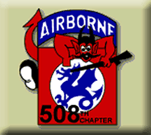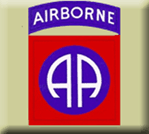Local Paratrooper in famous division-
Article from North Manchester News-Journal on September 5, 1944. Maps added courtesy of Thad Russell on December 13, 2000.
Back
Gueutteville, Chef-du-Pont, Carguebut, and Beuzeville are shown here in yellow boxes outlined in green. The Merderet River is also shown here indicated by the red line.
A large pocket of Allied resistance within enemy lines was set up. During the campaign it stretched from Sainte Mere on the east to St Sauveur le Vicomte on the west and from Le Ham on the north almost to La Haye de Puits on the south. This was accomplished in 33 days of action, without relief and without replacements. Every mission was accompished. No ground gained was ever relinquished. For nearly 34 hours, or until noon of the day after D-Day, the paratroopers were without contact with friendly forces. And though heavy casualties were sustained throughout the campaign, nothing stopped the troops. With other units of the division they forced the enemy west of the Merderet River at the start. Another element joined in the heavy fighting at Chef du Pont, finally contacting an isolated battalion and establishing a bridgehead on the west bank of the Merderet opposite Chef du Pont. Other elements went south to clear out Carquebut; crossed the river at La Fierre and assaulted Guetteville. The latter action was assisted by a naval barrage from the sea arranged by a naval laison officer with the regiment. After being pulled together as a unit, the regiment jumped off for the attack on Beuzeville la Bastille. After crossing the Douve, it swept on through the Cretteville-Baupte area. During this drive many enemy tanks were encountered and many were knocked out. Trucks moved the regiment to Pont l'Abbe for the general attack on St. Sauveur. The regiment followed another of the division, driving the enemy west, north and south.
The large green box indicates the area where the Allied pocket of resistance was concentrated.

Bois de Limors, Vindefontaine, Pretot, and la Haye-du-Puits are shown here in the yellow boxes outlined in green. You will also notice a yellow box outlined in green right above la Haye-du-Puits with no markings, that is "Hill 95".
Participating in the drive on Pretot, a squad encountered a Mark IV tank 600 yards north of the town and succeeded in knocking it out with a hand-thrown British grenade. The regiment took a defensive position at Vindefontaine before joining in the drive toward LaHaye dePuits. Heavy fighting was experienced in the Bois de Limors, and one element which eventually took "Hill 95" sustained heavy casualties. Colonel Roy E. Lindquist of Pittsfield, ME., the commanding officer, made a lucky guess which kept the enemy force on this hill from being greater than it was. He swept an orchard with fire. Later a prisoner said that a German force preparing for an assault on the hill had been virtually wiped out by this hit.


